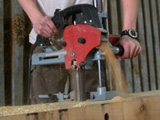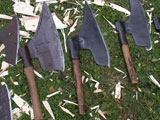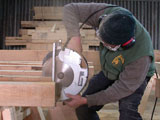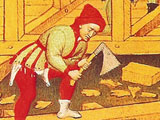Methods
The techniques we use are essentially the same as in use from the early middle ages, each timber is individually scribed to its partner and given a locating number. For repairs we still scribe each joint and hand finish all visible surfaces so that the new work sits a little more comfortably next to its ancient neighbours.
The most common joint employed is a mortice and tenon, each is draw-pegged together with hand cleft oak pegs exactly as has been done for centuries. Obviously we have to be cost effective so most of the cutting is now done with high spec. power tools and then hand finished as required.
New frames are raised with a crane for safety and efficiency although we often use more traditional methods on repair projects.
We are avid collectors of strange and ancient tools, these are often used in our everyday work and we always enjoy hand converting unusual shapes for new framing. In the past a broad axe was used for timber conversion and we have built up a large collection of these in recent years. Using historic tools gives us a very good insight into historic techniques and we regularly demonstrate these rare skills at dayschools and various shows around East Anglia. Rick has appeared on radio and television several times demonstrating traditional carpentry and regularly gives lectures on the subject.




